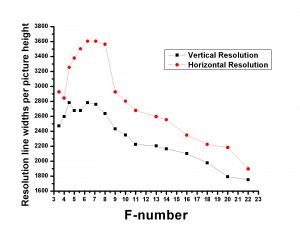Let’s continue our discussion of how to measure digital camera resolution. Using the procedure described in yesterdays blog, I measured the horizontal and vertical resolution of my Canon T2i with the S 18-55 lens (not the IS variant) set at 18mm. Multiplying by the 1.6 correction factor for the sensor size of 22.3 mm x 14.9 mm (5184 pixels x 3456 pixels) this is an effective focal length of 29 mm. Note also that this means that the pixel size is 4.3 um on a side.
The data is shown in Figure 1. We see three significant facts:
- With increasing f-number resolution rises at first and then falls.
- The horizontal and vertical resolution are different
- Horizon resolution maximizes at 2760 line widths per image height at ~ f-7.0
- Vertical resolution maximizes at 3605 line widths per image height also at ~f-7.0
What is the origin of the non-monotonic dependence of resolution on f-number? We’ve actually discussed both factors previously. In the blog on pinhole cameras, we saw how increasing f-number should increase image sharpness. However, in the blog on Camera Resolution and the Airy disk, we saw how as f-number increases sharpness ultimately becomes diffraction limited by the dimensions of the Airy disk. You can in fact use the simple relationship that the resolution = 1.22 X (wavelength of light) x f-number and ask when does this become equal to the pixel size of 4.3 um. For green light (wavelength = 0.55 um) this occurs at ~ f-7.0. Beyond that point, the diffraction spot from a point of light becomes greater than a pixel in dimension and the resolution ceases to be pixel limited and becomes diffraction limited instead.
We can in fact calculate how many pixels wide is the diffraction spot in our test. For instance for the horizontal data the image is 5184 lines wide, as defined by the pixel number, but only 3606 lines wide as defined by our measurement. This means a line is 1.4 pixels wide horizontally. A similar calculation gives you 1.2 pixels wide vertically.
All of this would appear to say that, at least at 29 mm zoom, this lens is performing very close to the pixel limit. It also suggests that best-performance f-number of 7.0 is sensor rather than lens dependent. This best-performance value is referred to as the DLA, for diffraction limited aperture, and matches the expected performance of the camera.


Pingback: Selecting a new lens | Hati and Skoll Gallery
Pingback: A note on MTFs for Nikon Users – and a note about dying bookstores | Hati and Skoll Gallery
Pingback: Digitizing 35 mm slides | Hati and Skoll Gallery